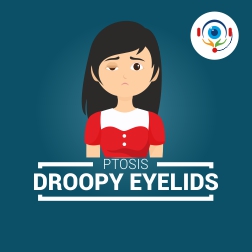Ptosis (Droopy Eyelids)
Disease
When the upper eyelid droops or is lower than it should be it leads to Ptosis. The eyelid may droop slightly or may completely cover the pupil or the eye.
Ptosis can affect either one or both the eyelids. And in some cases, it has the potential of restricting or blocking normal vision.
Causes
Ptosis or droopy eyelids is caused due to various reasons. It occurs when the muscles in charge of raising the eyelid are weak or there's damage in the nerves responsible for controlling those muscles or the skin of the upper eyelids are loose.
If ptosis is present at birth, it is called Congenital Ptosis.
These children may experience watery eyes, drooping of either one or both the eyelids or interference with vision if the ptosis is severe.
Diagnosis
Children with droopy eyelids more often than not tip their heads back, in the chin-up position, to see underneath their eyelids or may raise their eyebrows in an attempt to lift their eyelids.
If you notice your child doing any of the above, you must take your child to a general physician, who will then refer you to an eye doctor or ophthalmologist. It's always better to get your child diagnosed because abnormal head positions can cause deformities in the head and neck with time.
Your child may be asked to take certain tests like an Ocular Mobility or Eye Movement Test, Visual Field Testing or Slit-Lamp Examination to figure out whether it truly is ptosis.
Your doctor would ask your child to get other tests done in order to check whether the ptosis is a result of a disease or illness.
Treatment
If a child has ptosis and it remains untreated, it can lead to amblyopia or lazy eye. And not treating amblyopia could permanently compromise vision. Therefore, it becomes vital to treat ptosis.
If your child is born with moderate to severe ptosis, treatment will enable the development of normal vision. Childhood ptosis is usually corrected with surgery. However, in some cases it can be treated using medication.
Your ophthalmologist will first examine your child and then, based on the examination, will determine whether a surgery must be done or not. This will be based on a number factors like the child's age, whether one or both the child's eyelids has ptosis, lifting of the eyelid, closing muscle strength, measurement of the eyelid height and an observation of the movement of the eyes.
Surgery
Normally, surgery can be used to treat ptosis. During surgery, the levators or muscles that lift the eyes are tightened. If the ptosis is severe and the levators are extremely weak, the eyelid is attached or suspended from below the eyebrow. This is done so that the muscles of the forehead can perform the function of lifting.
Takeaway
Ptosis is either present at birth or may appear at a later time during adulthood because of an injury or disease. It's advisable to get it treated if it presents itself at birth.



